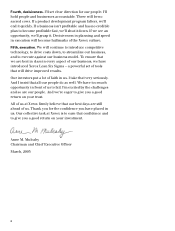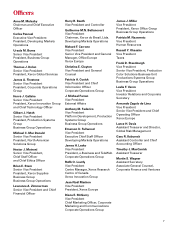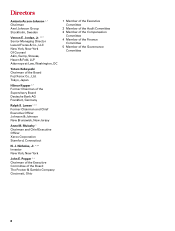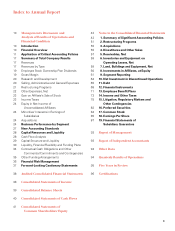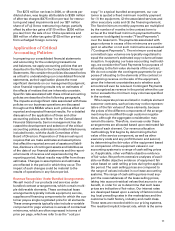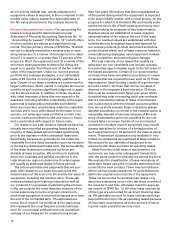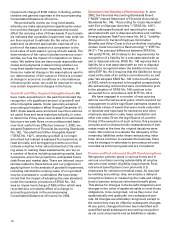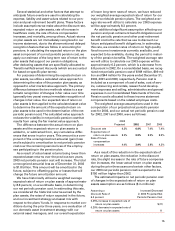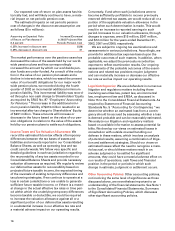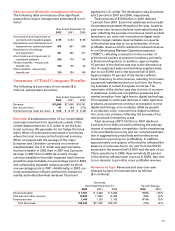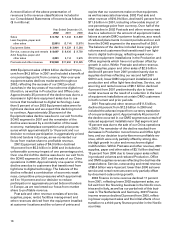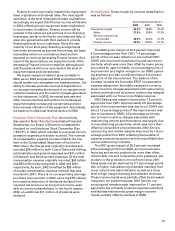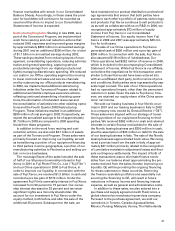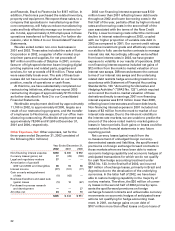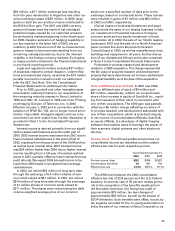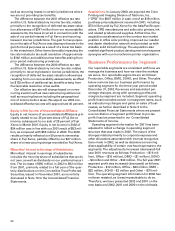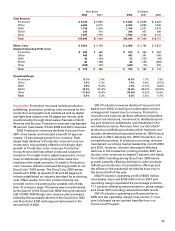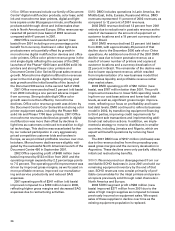Xerox 2002 Annual Report Download - page 18
Download and view the complete annual report
Please find page 18 of the 2002 Xerox annual report below. You can navigate through the pages in the report by either clicking on the pages listed below, or by using the keyword search tool below to find specific information within the annual report.
16
Our expected rate of return on plan assets has his-
torically had, and will likely continue to have, a mate-
rial impact on net periodic pension cost.
The estimated impacts on net periodic pension
cost of changes in the discount rate assumption are
as follows ($ in millions):
Assuming an Expected Rate Increase/(Decrease)
of Return on Plan Assets of in 2003 Projected Net
8.3 percent Periodic Pension Cost
0.25% increase in discount rate $(26)
0.25% decrease in discount rate 31
The market performance over the past two years has
decreased the value of the assets held by our world-
wide pension plans and has correspondingly
increased the amount by which our worldwide pen-
sion funds are under-funded. As a result of the reduc-
tion in the value of our pension plan assets and a
decline in interest rates, which increased the present
value of our benefit obligations for our major world-
wide pension plans, we recorded during the fourth
quarter of 2002 an incremental additional minimum
pension liability. This incremental liability was record-
ed through a non-cash charge to Shareholders’ Equity
as required by SFAS No. 87 “Employers’ Accounting
for Pensions.” The increase in the additional mini-
mum pension liability of $413 million resulted in an
incremental after-tax charge to Shareholders’ Equity
of $231 million. These amounts will increase or
decrease in the future based on the value of our pen-
sion obligations in relation to the value of the assets
held by our pension plans to settle such obligations.
Income Taxes and Tax Valuation Allowances: We
record the estimated future tax effects of temporary
differences between the tax bases of assets and
liabilities and amounts reported in our Consolidated
Balance Sheets, as well as operating loss and tax
credit carryforwards. We follow very specific and
detailed guidelines in each tax jurisdiction regarding
the recoverability of any tax assets recorded in our
Consolidated Balance Sheets and provide necessary
valuation allowances as required. We regularly review
our deferred tax assets for recoverability based on
projected future taxable income, the expected timing
of the reversals of existing temporary differences and
tax planning strategies. If we continue to operate at a
loss in certain jurisdictions or are unable to generate
sufficient future taxable income, or if there is a materi-
al change in the actual effective tax rates or time peri-
od within which the underlying temporary differences
become taxable or deductible, we could be required
to increase the valuation allowance against all or a
significant portion of our deferred tax assets resulting
in a substantial increase in our effective tax rate and
a material adverse impact on our operating results.
Conversely, if and when such jurisdictions were to
become sufficiently profitable to recover previously
reserved deferred tax assets, we would reduce all or a
portion of the applicable valuation allowance in the
period when such determination is made. This would
result in an increase to reported earnings in such
period. Increases to our valuation allowance, through
charges to expense, were $15 million, $247 million,
and $12 million for the years ended December 31,
2002, 2001 and 2000, respectively.
We are subject to ongoing tax examinations and
assessments in various jurisdictions. Accordingly, we
provide for additional tax expense based upon the
probable outcomes of such matters. In addition, when
applicable, we adjust the previously recorded tax
expense to reflect examination results. Our ongoing
assessments of the probable outcomes of the exami-
nations and related tax positions require judgment
and can materially increase or decrease our effective
tax rate as well as impact our operating results.
Legal Contingencies: We are a defendant in numerous
litigation and regulatory matters including those
involving securities law, patent law, environmental
law, employment law and ERISA, as discussed in
Note 15 to the Consolidated Financial Statements. As
required by Statement of Financial Accounting
Standards No. 5 “Accounting for Contingencies,” we
determine whether an estimated loss from a contin-
gency should be accrued by assessing whether a loss
is deemed probable and can be reasonably estimated.
We analyze our litigation and regulatory matters
based on available information to assess potential lia-
bility. We develop our views on estimated losses in
consultation with outside counsel handling our
defense in these matters, which involves an analysis
of potential results, assuming a combination of litiga-
tion and settlement strategies. Should our views on
estimated losses reflect the need to recognize a mate-
rial accrual, or should these matters result in an
adverse judgment or be settled for significant
amounts, they could have a material adverse effect on
our results of operations, cash flows and financial
position in the period or periods in which such
change in estimate, judgment or settlement occurs.
Other Accounting Policies: Other accounting policies,
not involving the same level of significance as those
discussed above, are nevertheless important to an
understanding of the financial statements. See Note 1
to the Consolidated Financial Statements, Summary
of Significant Accounting Policies, which discusses
other significant accounting policies.


